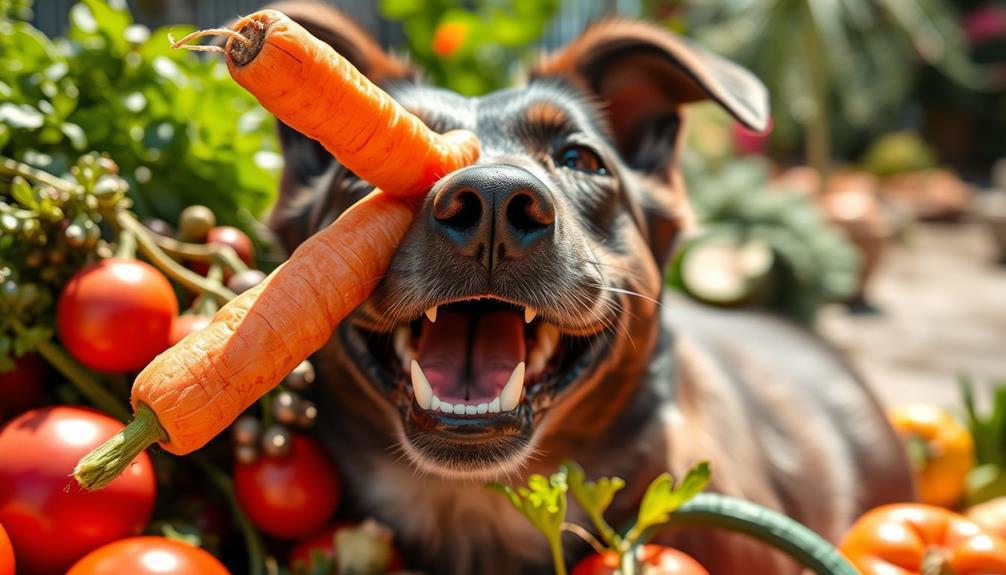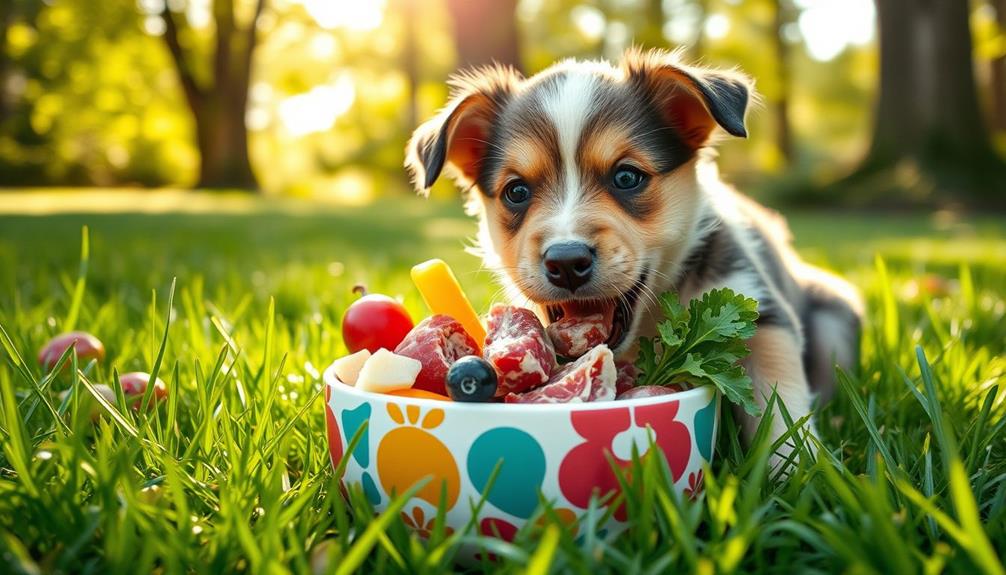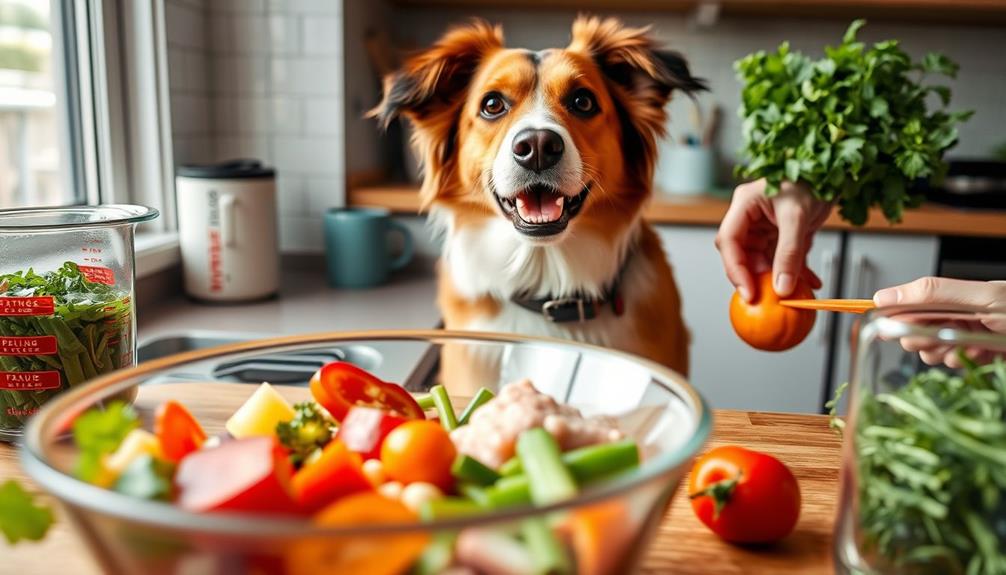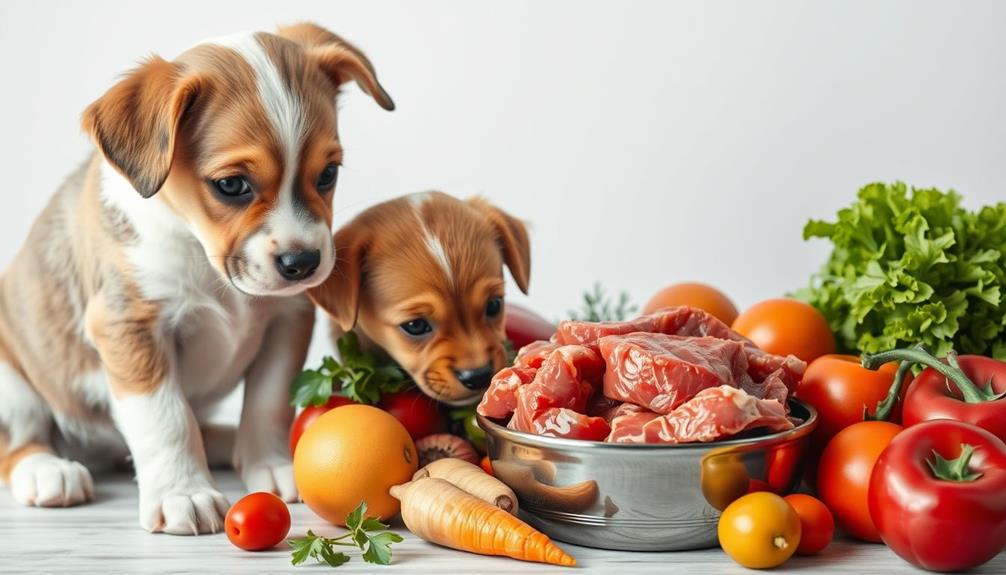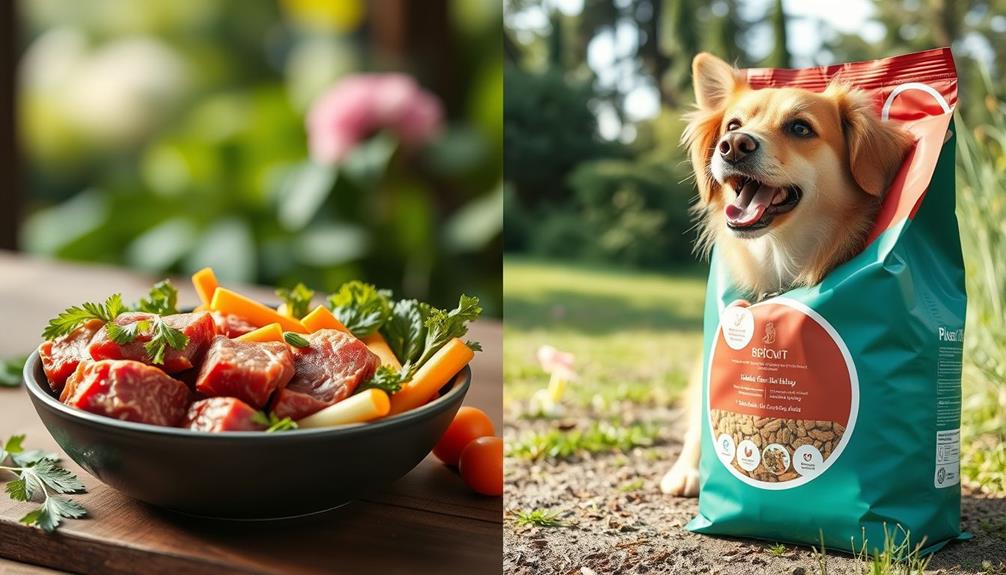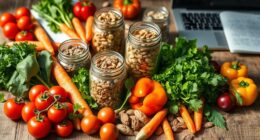Yes, raw food is better for your dog's teeth compared to kibble. Kibble often lacks the abrasive action needed to remove plaque effectively, leading to more dental issues. In contrast, raw meaty bones help scrub away plaque and reduce tartar buildup. Raw diets contain live enzymes and are low in starch, promoting better overall dental health. You'll notice fewer dental problems with a raw food diet. However, shifting to this diet requires care and planning to guarantee it meets your dog's nutritional needs. If you're curious to learn how to safely make this switch, you'll find valuable insights ahead.
Key Takeaways
- Raw food diets, particularly with raw meaty bones, help scrub away plaque more effectively than kibble.
- The low starch content in raw food reduces the buildup of tartar and supports better dental health.
- Chewing raw bones promotes gum health and minimizes infections, contributing to overall oral hygiene.
- Dogs on raw diets generally experience fewer dental problems, underscoring the importance of diet in dental health.
- Transitioning to a raw diet should be done gradually and with veterinary guidance to ensure balanced nutrition.
Impact of Diet on Dental Health
The impact of diet on your dog's dental health is substantial. When you feed your dog kibble, you're not doing much for their teeth. Kibble lacks the abrasive action needed to effectively scrape away plaque buildup. Instead, it often leads to bacteria feeding on carbohydrates, causing more plaque and tartar buildup. This means your dog's oral health can suffer, resulting in bad breath and potential dental issues.
Additionally, incorporating fresh fruits and vegetables can provide additional benefits, as certain options can be safe snacks for dogs and contribute to overall health, similar to how proper diet affects hamster care.
On the other hand, a raw diet, especially one that includes raw meaty bones, can be a game changer. Chewing on these bones helps scrub away plaque and keeps gums healthy. It's no surprise that regular consumption of raw meaty bones considerably reduces tartar buildup compared to kibble diets, leading to cleaner teeth and fresher breath.
Plus, raw food is low in starch and contains live enzymes that promote better dental health.
Symptoms of Dental Disease
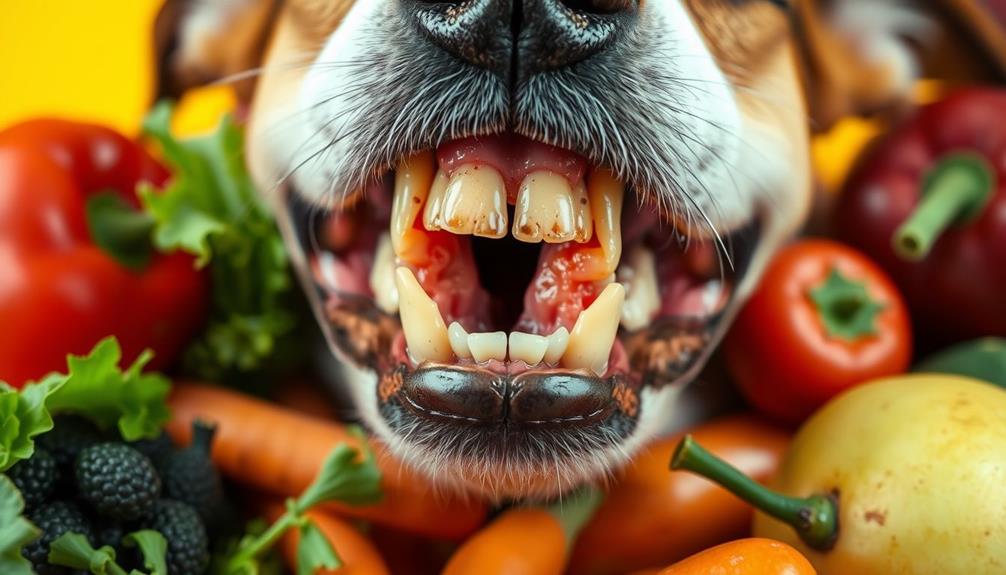
When you notice changes in your dog's behavior or health, dental disease might be the culprit. One of the first signs is gingivitis, where you may see inflamed, puffy, and bleeding gums. This condition often results from plaque buildup and can lead to more serious issues.
Just as individuals with emotional dysregulation may exhibit behavioral changes, dogs can also show alterations in behavior due to dental pain or discomfort. If your dog has bad breath, known as halitosis, that's another indicator that something's off with their dental health.
Keep an eye out for excessive drooling or blood on chew toys, as these can signal oral pain or discomfort. If your dog has loose or missing teeth, it may point to periodontitis, a severe form of dental disease that weakens jaw structures and can lead to fractures.
Additionally, changes in your dog's demeanor, such as irritability or a reduced appetite, often accompany dental discomfort.
If you notice any of these symptoms, it's crucial to seek a veterinary evaluation. Early detection and treatment can help prevent further complications and safeguard your dog's overall well-being.
Don't ignore these signs; your dog relies on you to keep their health in check.
Benefits of Raw Diet

A raw diet offers several benefits for your dog's dental health that can't be overlooked. By incorporating raw meaty bones, you provide an abrasive action that scrapes plaque off your dog's teeth, promoting better dental health than kibble diets. Raw food is low in starch and contains live enzymes, which help prevent dental issues. When choosing the best raw food for dogs, it’s important to consider a balanced diet that includes a variety of meats, bones, and organs to ensure your dog receives all the essential nutrients they need. Look for high-quality, organic options that are free from additives and artificial ingredients to support your dog’s overall health and well-being. Additionally, incorporating raw vegetables and fruits can provide additional dental benefits and support your dog’s oral hygiene.
Here's a quick overview of the benefits:
| Benefit | Description | Impact on Dental Health |
|---|---|---|
| Plaque Removal | Chewing raw meaty bones scrapes plaque off teeth | Reduces plaque and improves oral hygiene |
| Tartar Buildup | Low starch content helps reduce tartar accumulation | Supports healthier teeth and gums |
| Gum Health | Natural chewing action enhances gum health | Leads to fresher breath and reduced infections |
| Immune System | Nutritional integrity supports overall health | Promotes a stronger immune system |
Dogs on a raw diet often experience fewer dental problems, highlighting the importance of nutritional integrity in maintaining oral health. With better gum health and reduced tartar buildup, you'll notice significant health benefits for your furry friend.
Transitioning to Raw Diet
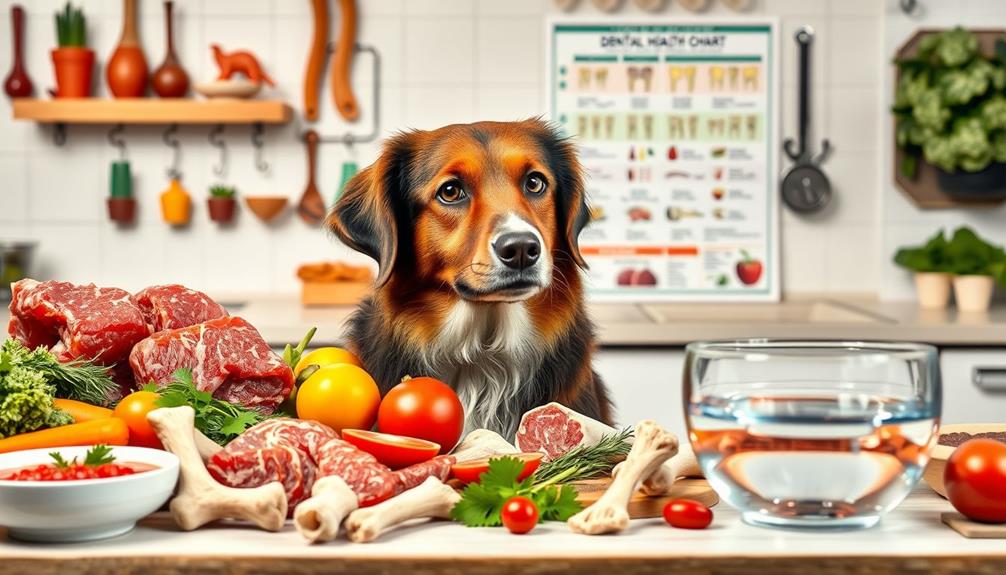
Shifting to a raw diet can be a rewarding journey for both you and your dog, especially when you consider the dental health benefits. Changing to a raw diet involves incorporating raw meaty bones, which provide the necessary abrasive action to scrape plaque off your dog's teeth effectively.
Financial considerations for elderly care are also important to keep in mind when making decisions about long-term pet care. Even partial incorporation of raw food can lead to improved dental outcomes, thanks to its lower starch content and live enzymes that help prevent dental issues.
To guarantee a smooth changeover, it's essential to introduce raw food gradually. Start with small amounts mixed into your dog's current diet, slowly increasing the raw proportion while monitoring for any signs of digestive upset. This method allows your dog's digestive system to adjust without causing distress.
Before making any dietary changes, a veterinarian consultation is vital. Your vet can help you create a balanced nutrition plan tailored to your dog's individual health needs.
With resources like We Feed Raw offering balanced meal plans and portioned packaging, you'll find it easier to navigate the change. Embrace the journey toward a healthier diet that benefits your dog's dental health and overall well-being!
Safety and Considerations
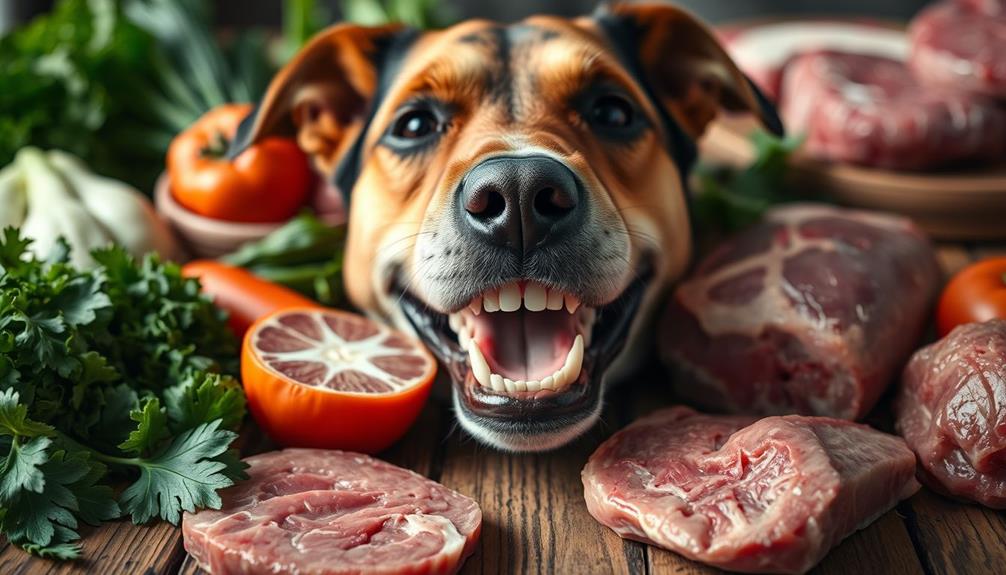
Guaranteeing safety and proper handling is vital when introducing a raw food diet for your dog. While raw food diets can improve dental health and gum health, they come with their own set of considerations. To minimize risks, keep these points in mind:
- Always implement strict hygiene practices to prevent bacterial contamination. For instance, understanding the importance of cold medications overview can help in making informed decisions about your dog's health.
- Handle raw meat carefully, washing your hands and surfaces thoroughly after preparation.
- Consult your veterinarian to verify the diet meets your dog's nutritional needs and avoids imbalances.
- Monitor your dog for any adverse reactions after shifting to feeding raw.
Raw bones can aid in dental health by reducing plaque, but be cautious as they can also pose choking hazards or splinter.
Adapting to a raw food diet should be a well-planned process, emphasizing balanced nutrition while maintaining proper handling techniques. Regular veterinary consultation is essential to tailor the diet to your dog's specific health requirements.
Frequently Asked Questions
Is Raw Diet Better for Dog Teeth?
You might find a raw diet beneficial for your dog's teeth. The chewing action involved can help scrape plaque away, promote healthier gums, and reduce bad breath, leading to improved overall dental health for your pet.
What Is the Truth About Raw Dog Food?
Imagine your dog's teeth as a garden. Raw dog food nurtures that garden, promoting vibrant health and freshness. The truth is, raw diets enhance dental hygiene, reducing plaque and supporting healthier gums compared to traditional kibble. Additionally, raw food benefits for dogs extend beyond dental health. It can also improve digestion, increase energy levels, and promote a shinier coat. By feeding your dog a raw diet, you are providing them with the essential nutrients and enzymes that may be lacking in processed commercial dog food. Overall, raw food benefits for dogs can result in a happier and healthier furry friend.
Why Do Vets Disagree With Raw Feeding?
Vets disagree with raw feeding due to concerns about pathogenic bacteria, nutritional imbalances, and the lack of scientific support. They recommend balanced commercial diets and stress consulting professionals before making significant dietary changes for your pet.
Is Raw Really Better for Dogs?
When you ponder if raw's truly better for dogs, think of vibrant gardens bursting with life versus dull, lifeless landscapes. Raw diets can invigorate your pup, promoting health and energy like a revitalizing breeze on a warm day.
Conclusion
In the grand scheme of your dog's health, a raw diet can be a delightful twist that may enhance their dental journey. By embracing this fresh approach, you might just uncover a hidden gem for their pearly whites. While shifting, keep an eye on safety and your furry friend's unique needs. With a bit of care, you could find that a raw diet not only supports their teeth but also adds a spark to their overall well-being.

